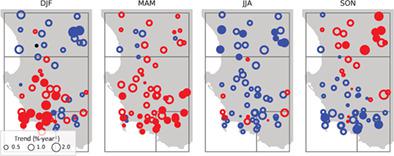当前位置:
X-MOL 学术
›
Int. J. Climatol.
›
论文详情
Our official English website, www.x-mol.net, welcomes your feedback! (Note: you will need to create a separate account there.)
Spatio‐temporal patterns of rainfall trends and the 2015–2017 drought over the winter rainfall region of South Africa
International Journal of Climatology ( IF 3.9 ) Pub Date : 2020-07-24 , DOI: 10.1002/joc.6768 Piotr Wolski 1 , Stefaan Conradie 1 , Christopher Jack 1 , Mark Tadross 1
International Journal of Climatology ( IF 3.9 ) Pub Date : 2020-07-24 , DOI: 10.1002/joc.6768 Piotr Wolski 1 , Stefaan Conradie 1 , Christopher Jack 1 , Mark Tadross 1
Affiliation

|
We analyse long‐term (1900–2017) rainfall data in the southern part of the winter rainfall region of southern Africa to understand the spatial patterns of recent and long‐term trends and contextualize the 2015–2017 rainfall anomalies which led to the so‐called “Day Zero” drought in Cape Town. Our analyses reveal cohesive spatial patterns and seasonal differences in rainfall trends across a range of timescales. These suggest that rainfall is subject to regional driving mechanisms, predominantly manifested at the 20–50 year timescale, but the influence of these mechanisms is modified by subregional and seasonally specific processes, frequently resulting in trends of different magnitudes and even sign. Trend patterns are consistent with multidecadal‐scale quasi‐periodicity, with only the most recent phase (post‐1981 drying) corresponding to the expected regional response to hemispheric processes linked to anthropogenic climate change. The spatial and seasonal patterns of drying observed since 1981 alone do not explain the pattern of 2015–2017 drought anomalies, although they share a strong autumn and weak mid‐winter signal. These results have implications to the interpretation of drought in the context of observed rainfall trends. Furthermore, we identify directions for improvement of the conceptual understanding of drivers of rainfall variability and the role of anthropogenic climate change in the winter rainfall region of South Africa.
中文翻译:

南非冬季降雨区域降雨趋势的时空格局和2015-2017年干旱
我们分析了南部非洲冬季降雨区南部的长期(1900–2017)降雨数据,以了解近期和长期趋势的空间格局,并结合了2015–2017年降雨异常的背景,从而导致了-开普敦称为“零日干旱”。我们的分析揭示了在各个时间范围内的凝聚力空间格局和降雨趋势的季节性差异。这些表明降雨受区域驱动机制的影响,主要表现在20-50年的时间尺度上,但是这些机制的影响会因次区域和季节性特定过程而改变,经常导致不同幅度甚至标志的趋势。趋势模式与多年代尺度的准周期一致,只有最近的阶段(1981年后的干燥)对应于与人为气候变化相关的对半球过程的预期区域响应。尽管自1981年以来观测到的干旱的空间和季节变化模式具有很强的秋季信号和弱的冬季初信号,但并不能解释2015-2017年的干旱异常情况。这些结果对观察到的降雨趋势中的干旱解释具有影响。此外,我们确定了改善对降雨变化的驱动因素以及南非冬季降雨地区人为气候变化的作用的概念性理解的方向。尽管自1981年以来观测到的干旱的空间和季节变化模式说明了强烈的秋季和弱冬的信号,但并不能解释2015-2017年干旱异常的模式。这些结果对观察到的降雨趋势中的干旱解释具有影响。此外,我们确定了改善对降雨变化的驱动因素以及南非冬季降雨地区人为气候变化的作用的概念性理解的方向。尽管自1981年以来观测到的干旱的空间和季节变化模式具有很强的秋季信号和弱的冬季初信号,但并不能解释2015-2017年的干旱异常情况。这些结果对观察到的降雨趋势中的干旱解释具有影响。此外,我们确定了改善对降雨变化的驱动因素以及南非冬季降雨地区人为气候变化的作用的概念性理解的方向。
更新日期:2020-07-24
中文翻译:

南非冬季降雨区域降雨趋势的时空格局和2015-2017年干旱
我们分析了南部非洲冬季降雨区南部的长期(1900–2017)降雨数据,以了解近期和长期趋势的空间格局,并结合了2015–2017年降雨异常的背景,从而导致了-开普敦称为“零日干旱”。我们的分析揭示了在各个时间范围内的凝聚力空间格局和降雨趋势的季节性差异。这些表明降雨受区域驱动机制的影响,主要表现在20-50年的时间尺度上,但是这些机制的影响会因次区域和季节性特定过程而改变,经常导致不同幅度甚至标志的趋势。趋势模式与多年代尺度的准周期一致,只有最近的阶段(1981年后的干燥)对应于与人为气候变化相关的对半球过程的预期区域响应。尽管自1981年以来观测到的干旱的空间和季节变化模式具有很强的秋季信号和弱的冬季初信号,但并不能解释2015-2017年的干旱异常情况。这些结果对观察到的降雨趋势中的干旱解释具有影响。此外,我们确定了改善对降雨变化的驱动因素以及南非冬季降雨地区人为气候变化的作用的概念性理解的方向。尽管自1981年以来观测到的干旱的空间和季节变化模式说明了强烈的秋季和弱冬的信号,但并不能解释2015-2017年干旱异常的模式。这些结果对观察到的降雨趋势中的干旱解释具有影响。此外,我们确定了改善对降雨变化的驱动因素以及南非冬季降雨地区人为气候变化的作用的概念性理解的方向。尽管自1981年以来观测到的干旱的空间和季节变化模式具有很强的秋季信号和弱的冬季初信号,但并不能解释2015-2017年的干旱异常情况。这些结果对观察到的降雨趋势中的干旱解释具有影响。此外,我们确定了改善对降雨变化的驱动因素以及南非冬季降雨地区人为气候变化的作用的概念性理解的方向。



























 京公网安备 11010802027423号
京公网安备 11010802027423号